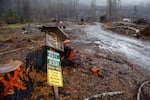Oregon is set to receive millions from the recently signed infrastructure bill to improve forest health and reduce wildfire risks.
On Monday, U.S. Agriculture Secretary Tom Vilsack, U.S. Rep. Kurt Schrader, D-Ore., and Oregon Gov. Kate Brown held a virtual roundtable event to discuss the effects of climate change in Oregon. Over the past 20 months, Oregon has experienced wildfires that have collectively burned more than 1.8 million acres and more than 4,000 homes. The state also experienced record-breaking heat waves that killed 116 people, including at least 3 people on the job — all while also dealing with a historic drought.
The Infrastructure Investment and Jobs Act, signed into law last month by President Joe Biden, will steer roughly $5 billion into the state over the next five years. At least $39 million is to support wildfire risk reduction efforts that will include money for prescribed burning and forest thinning.
Debate continues to play out among forest scientists and the timber industry about whether prescribed burning or tree cutting are the most effective ways to restore forest health. But there is a growing consensus that forests have become tinderboxes of overgrown brush and dense-growing trees, after decades of aggressive fire suppression.

Fire damage in Elkhorn, Ore., Feb. 26, 2021, after the Beachie Creek Fire devastated the area in 2020.
Kristyna Wentz-Graff / OPB
Overall, the bill directs $3.4 billion for nationwide wildfire risk reduction. Vilsack said the spending reflects a growing awareness of the risks of climate change.
“We now have a more comprehensive understanding on the part of [the] American public about the consequences of climate and the impact that that is now having in terms of threatening lives and property, and the cost of the damage that’s done as a result of disasters that are climate related,” Vilsack told OPB.
From 2010 to 2020, Oregon has experienced 12 extreme weather events, costing the state up to $5 billion in damages, according to the White House Infrastructure Bill fact sheet.
Schrader, who was part of an effort to keep the infrastructure bill on track when its fate was uncertain, said he expects the increased federal spending to be accompanied by closer coordination between the U.S. Forest Service and Oregon’s state foresters, private landowners and the conservation community.
“We’re actually going to be able to give Oregonians confidence that there’s a plan to address firefighting,” he said.
